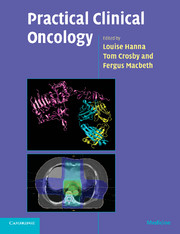Book contents
- Frontmatter
- Contents
- List of contributors
- Preface
- Acknowledgements
- Abbreviations
- 1 Practical issues in cytotoxic chemotherapy usage
- 2 Biological treatments in cancer
- 3 Hormones in cancer
- 4 Radiotherapy planning
- 5 Research in cancer
- 6 Oncological emergencies
- 7 Palliative care
- 8 Head and neck
- 9 Oesophagus
- 10 Stomach
- 11 Liver, gallbladder and biliary tract
- 12 Exocrine pancreas
- 13 Colon and rectum
- 14 Anus
- 15 Gastrointestinal stromal tumours
- 16 Breast
- 17 Kidney
- 18 Bladder
- 19 Prostate
- 20 Testis
- 21 Penis
- 22 Ovary
- 23 Body of the uterus
- 24 Cervix
- 25 Vagina
- 26 Vulva
- 27 Gestational trophoblast tumours
- 28 Lung
- 29 Mesothelioma
- 30 Soft tissue and bone tumours in adults
- 31 The lymphomas and myeloma
- 32 Central nervous system
- 33 Skin cancer other than melanoma
- 34 Melanoma
- 35 Thyroid
- 36 Neuroendocrine tumours
- 37 Cancer in children
- 38 Cancer of unknown primary
- 39 The use of radiotherapy in the treatment of benign conditions
- Multiple choice questions
- Multiple choice answers
- Index
- References
12 - Exocrine pancreas
Published online by Cambridge University Press: 23 December 2009
- Frontmatter
- Contents
- List of contributors
- Preface
- Acknowledgements
- Abbreviations
- 1 Practical issues in cytotoxic chemotherapy usage
- 2 Biological treatments in cancer
- 3 Hormones in cancer
- 4 Radiotherapy planning
- 5 Research in cancer
- 6 Oncological emergencies
- 7 Palliative care
- 8 Head and neck
- 9 Oesophagus
- 10 Stomach
- 11 Liver, gallbladder and biliary tract
- 12 Exocrine pancreas
- 13 Colon and rectum
- 14 Anus
- 15 Gastrointestinal stromal tumours
- 16 Breast
- 17 Kidney
- 18 Bladder
- 19 Prostate
- 20 Testis
- 21 Penis
- 22 Ovary
- 23 Body of the uterus
- 24 Cervix
- 25 Vagina
- 26 Vulva
- 27 Gestational trophoblast tumours
- 28 Lung
- 29 Mesothelioma
- 30 Soft tissue and bone tumours in adults
- 31 The lymphomas and myeloma
- 32 Central nervous system
- 33 Skin cancer other than melanoma
- 34 Melanoma
- 35 Thyroid
- 36 Neuroendocrine tumours
- 37 Cancer in children
- 38 Cancer of unknown primary
- 39 The use of radiotherapy in the treatment of benign conditions
- Multiple choice questions
- Multiple choice answers
- Index
- References
Summary
Introduction
Nearly 7000 new cases of pancreatic carcinoma are diagnosed in the UK each year and nearly as many patients die from the disease. The major risk factors include smoking, diet and a previous total gastrectomy. There is also a positive association between long-standing diabetes and pancreatic cancer. Surgery is the only curative option, but fewer than 20% of patients are suitable for this approach. Gemcitabine-based chemotherapy is the mainstay of treatment for fit patients with advanced or metastatic cancers. Chemoradiation is an option for locally advanced disease. There has been growing interest in combining gemcitabine with radiotherapy (including newer radiotherapy techniques like IMRT), biological agents (cetuximab, erlotinib and bevacizumab), and other chemotherapy agents (oxaliplatin and capecitabine).
Types of pancreatic tumour
Benign cysts can be congenital and they arise from anomalous development of the pancreatic ducts. Pseudocysts are loculated collections of fluid arising from necrosis, inflammation or haemorrhage. They are often solitary, can measure 5 to 10 cm and are often found adjacent to the pancreas in the region of the tail. Benign cystadenomas occur in elderly women and are found incidentally at autopsy or during other investigations. Microcystic and papillary-cystic variants are found in younger women. The types of pancreatic tumour are shown in Table 12.1.
Incidence and epidemiology
There are about 7000 new cases of pancreatic cancer in the UK each year and almost as many die from the disease.
- Type
- Chapter
- Information
- Practical Clinical Oncology , pp. 151 - 158Publisher: Cambridge University PressPrint publication year: 2008



